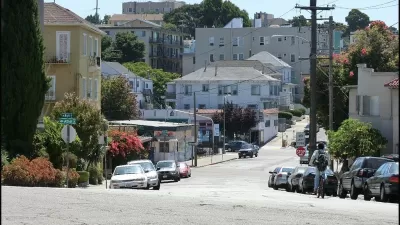The city that invented single-family zoning in 1916, for discriminatory purposes, will completely remove that exclusionary legacy from its zoning code.

The Berkeley City Council, the very first city in the United States to implement single-family zoning, now commonly referred to as exclusionary zoning, has voted to completely upend that legacy.
By a unanimous vote of 9-0, the Berkeley City Council last night decided to end single-family zoning citywide, the latest in a string of U.S. cities to reform the planning and zoning status quo. Earlier this year, Sacramento approved similar actions. Berkeley Councilmember and Vice Mayor Lori Droste, along with councilmembers Terry Tapli, Ben Bartlett, and Rigel Robinson, authored the ordinance, which moved quickly after first being introduced at the beginning of February.
"In 1916, single-family zoning was born in Berkeley’s Elmwood neighborhood, forbidding the construction of anything other than one home on each lot. At the time, an ordinance stated that its intent was to protect 'the home against the intrusion of the less desirable and floating renter class,'" reports Sarah Ravani in an article that preceded a late-night vote on February 23.
The vote follows on the heels of several significant planning reforms in recent months. In December 2020, the city "approved rezoning the Adeline Street corridor and even added an extra floor of height to what builders could do there. The plan allows 1,450 new housing units, about half for low-income families in an area that was once a thriving Black, working-class community, but has become increasingly white as the high cost of housing has driven out many families."
And in January, the City Council voted to eliminate parking requirements for almost all residential properties in the city.
The vote only starts the process of updating the city's zoning code to eliminate zoning, a prices expected to be complete by December 2022. Then, of course, the new regulatory regime and the market will require time to shows effects of the change in the city. As made clear by Councilmember Droste during the hearing, even after the zoning changes, single-family housing will still be permitted in much of the city—it just won't be the only kind of housing permitted. (The city of Minneapolis, with a head start on a similar process, recently reached the crucial concluding phase of a similar zoning reform process.)
FULL STORY: Berkeley considers ending single-family zoning by December 2022: A 'big deal'

Alabama: Trump Terminates Settlements for Black Communities Harmed By Raw Sewage
Trump deemed the landmark civil rights agreement “illegal DEI and environmental justice policy.”

Planetizen Federal Action Tracker
A weekly monitor of how Trump’s orders and actions are impacting planners and planning in America.

The 120 Year Old Tiny Home Villages That Sheltered San Francisco’s Earthquake Refugees
More than a century ago, San Francisco mobilized to house thousands of residents displaced by the 1906 earthquake. Could their strategy offer a model for the present?

In Both Crashes and Crime, Public Transportation is Far Safer than Driving
Contrary to popular assumptions, public transportation has far lower crash and crime rates than automobile travel. For safer communities, improve and encourage transit travel.

Report: Zoning Reforms Should Complement Nashville’s Ambitious Transit Plan
Without reform, restrictive zoning codes will limit the impact of the city’s planned transit expansion and could exclude some of the residents who depend on transit the most.

Judge Orders Release of Frozen IRA, IIJA Funding
The decision is a victory for environmental groups who charged that freezing funds for critical infrastructure and disaster response programs caused “real and irreparable harm” to communities.
Urban Design for Planners 1: Software Tools
This six-course series explores essential urban design concepts using open source software and equips planners with the tools they need to participate fully in the urban design process.
Planning for Universal Design
Learn the tools for implementing Universal Design in planning regulations.
Clanton & Associates, Inc.
Jessamine County Fiscal Court
Institute for Housing and Urban Development Studies (IHS)
City of Grandview
Harvard GSD Executive Education
Toledo-Lucas County Plan Commissions
Salt Lake City
NYU Wagner Graduate School of Public Service





























